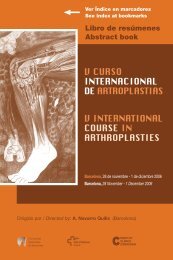Notas / Notes - Active Congress.......
Notas / Notes - Active Congress.......
Notas / Notes - Active Congress.......
Create successful ePaper yourself
Turn your PDF publications into a flip-book with our unique Google optimized e-Paper software.
VIERNES / FRIDAY<br />
222<br />
REFERENCES<br />
1. Christie MJ. Clinical applications of Trabecular Metal. Am<br />
J Orthop. 2002 Apr;31(4):219-20.<br />
2. Cohen R. A porous tantalum trabecular metal: basic science.<br />
Am J Orthop. 2002 Apr;31(4):216-7. Review.<br />
3. Dennis DA, Little LR. The structural allograft composite<br />
in revision total knee arthroplasty. Orthopedics. 2005<br />
Sep;28(9):1005-7.<br />
4. Gross AE, Goodman SB. Rebuilding the skeleton: the intraoperative<br />
use of trabecular metal in revision total hip<br />
arthroplasty.J Arthroplasty. 2005 Jun;20(4 Suppl 2):91-3<br />
5. Nelson CL, Lonner JH, Lahiji A, Kim J, Lotke PA. Use of<br />
a trabecular metal patella for marked patella bone loss<br />
during revision total knee arthroplasty. J Arthroplasty.<br />
2003 Oct;18(7 Suppl 1):37-41.<br />
6. Paprosky WG, O’Rourke M, Sporer SM.The treatment of<br />
acetabular bone defects with an associated pelvic discontinuity.<br />
Clin Orthop Relat Res. 2005 Dec;441:216-20.<br />
7. Rosenberg AG. The use of bone graft for managing bone<br />
defects in complex total knee arthroplasty. Am J Knee<br />
Surg. 1997 Winter;10(1):42-8.<br />
8. Stiehl JB Trabecular metal in hip reconstructive surgery.<br />
Orthopedics. 2005 Jul;28(7):662-70.<br />
BONE GROWTH ENHACING FACTORS<br />
Thomas J. Moore<br />
Emory University. Scool of Medicine Atlanta,<br />
Georgia (USA)<br />
MANAGEMENT OF PERIPROSTHETIC<br />
FRACTURES IN TOTAL KNEE<br />
ARTHROPLASTY<br />
E. Carlos Rodríguez-Merchán, MD, PhD<br />
Department of Orthopaedics, La Paz University Hospital,<br />
Madrid, (Spain)<br />
INTRODUCTION<br />
When a treatment option is chosen in a peri-prosthetic fracture<br />
of the knee, consideration must be given to multiple factors<br />
including:<br />
- The status of the prosthetic fixation<br />
- The degree of comminution of the fracture<br />
- The proximity of the fracture to the prosthetic component<br />
- The longitudinal alignment of the limb<br />
- The degree of displacement of the fracture (table 1)<br />
- The extent of osteoporosis<br />
Table 1. Classification of periprosthetic supracondylar<br />
fractures (Rorabeck et al, Instr Course Lect 1998;<br />
47:449-458)<br />
Type 1 Undisplaced fracture – Prosthesis stable<br />
Type 2 Displaced fracture – Prosthesis stable<br />
Type 3 Displaced or undisplaced fracture – Prosthesis<br />
loose or failing<br />
TYPES OF BONE FIXATION<br />
- Rush rods plus cement<br />
- Condylar blade-plate<br />
- Supracondylar locked rod<br />
- LISS (better, if rapid mobilization is needed<br />
TREATMENT OF TYPE 3 FRACTURES<br />
A displaced or undisplaced supracondylar fracture adjacent<br />
to a loose or failing total knee implant (type 3 fracture) can<br />
be treated in one of two ways: like a displaced supracondylar<br />
fracture (type 2 fracture), with revision of the implant at a<br />
later date, or with revision of the implant as part of the fracture<br />
stabilization.<br />
If the surgeon performs a revision, the implant should be<br />
replaced with a long-stemmed femoral component, a custommade<br />
component or tumor prosthesis, or an allograft-implant<br />
composite that also replaces the damaged distal aspect of<br />
the femur.





